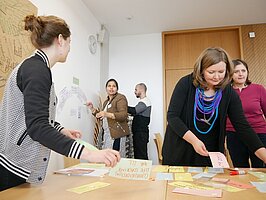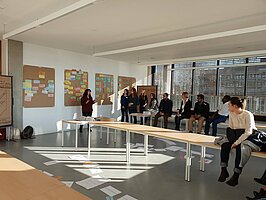Consensus Workshop



Aim of the method/strategy
Different applications are possible:
- to agree on common objectives or set priorities
- to discover hidden relationships between different factors (e.g. barriers to participation in adult learning)
- to brainstorm/organize ideas
Setting
- In a classroom or meeting room, mobile chairs, large and visible space on the wall
Type and name of the course, curriculum, number of students
- We tested it at a workshop on facilitation for other NGOs (25 participants), which aimed at discussing good facilitation methods and the qualities of a good facilitator.
Description of the method/strategy
- Before the workshop, the focus question is established. It refers to the question that is going to be answered by the workshop (e.g. what are the most important barriers to participation in adult learning?). Materials are prepared in advance (see “materials required”).
- Setting the context: At the beginning of the workshop, the facilitator states the purpose and aim of the workshop, clarifies the focus question, and explains the process and time frame (5-10 minutes).
- Brainstorming: The participants are asked to reflect on the question individually, and then to team up in small groups (of 2-5 people) to discuss the ideas. Instruction cards (see materials required) are put up on the wall. Each group is asked to write down their answers on the cards/post-its. Read the instructions from the instruction cards out loud (One idea per card – 3-7 words per card – X cards per group – write in large letters). The instruction cards should stay on the wall as a reminder during the brainstorming. Each group is asked to pick an X number of cards with the clearest/most important answers. The cards/post-its are put on the wall; the facilitator asks if any of the cards are unclear (10-20 minutes).
- Clustering: The facilitator asks the groups to put together 4-6 pairs of cards that they think go together intuitively. S/he asks if they would like to go back to any of their remaining cards and add them to the existing pairs together to form clusters. Once a few clusters are created, the facilitator asks them to add symbols to mark them. The participants decide together where to put the cards that were not joined in any cluster. The facilitator checks again if the participants would like to add any of their original ideas (10-20 minutes).
- Naming: The facilitator starts with the largest cluster and asks how it could be named (e.g. which 3-7 words best describe all of the cards in this cluster? Which title would include all of the ideas in these cards?). S/he can help the group by indicating that it would be useful to look for a noun/descriptive adjective/verb. It is important to reach consensus on the name, write it down, and put it up next to the cluster symbol (15-30 minutes).
- Resolving: The facilitator reads all of the names on the clusters and leads a discussion on whether any new ideas have come up/if anything has been left out. You can try to make a chart/visual image of the different clusters if the group thinks they are linked. Discuss the implications/next steps (e.g. What could adult education providers/policymakers do to help remove these barriers?) (5-15 minutes).
Materials required
- Large post-its / cards and scotch tape
- instruction cards for brainstorming (One idea per card – 3-7 words per card – X cards per group – write big)
- cards with symbols
- markers
Origins and theoretical framework
The Technology of Participation (ToP) Consensus Workshop was developed by the Institute of Cultural Affairs, which is a global network of organizations that “advance human development”. They developed a few methods for facilitating participative meetings/workshops. More information is available at this link: https://martingilbraith.com/2016/11/21/introducing-icas-technology-of-participation/.
Risks and advantages
Risks:
- The focus question needs to be well-phrased – “what”/“how” questions work best, e.g., What is needed to improve outreach work in our community? Who do we need to cooperate with?
- Time management is important – it’s easy to spend a lot of time on the brainstorming part and then risk having little time for resolving.
- The key aspect of the method is getting a consensus from all participants at every stage (Does everyone agree? Does this word best represent the ideas on these cards? etc.). The workshop might easily get disrupted if one of the participants has a very different opinion than the others.
Advantages:
- Participant-driven – the role of the teacher/educator is to facilitate the process.
- Participants first work individually, then in a small group, then in a bigger group – it encourages active participation of those that need more time to speak up in a new environment.
- Helps to generate new ideas, form new relationships between problems.
- For international groups, it might help to see the similarities in their working contexts (more than the differences, which in itself could be a weakness).
- Can be used to show that there are no wrong ideas – at one of the stages, participants are encouraged to reflect back on their earlier ideas and reuse them.
Possible variations
We used it at a workshop on facilitation. The main purpose of the workshop was to explain the method itself. We used some elements of the method at the beginning of the last Younger Staff Training to discuss participants’ expectations. The Younger Staff Training is an annual training programme for young professionals in adult education who would like to exchange ideas on topical issues with their European peers and to learn more about EU policy and advocacy work. More information is available on EAEA’s website: https://eaea.org/our-work/capacity-building/eaea-trainings/.
Recommendations
There are quite a few materials to prepare in advance: the instruction cards, post-its, and cards with symbols. Prepare a few extra symbol cards in case your participants think of more clusters than you thought they would. Use a different colour for cards with ideas and for those with names (ideally also a different size).
Contact Person
Aleksandra Kozyra (aleksandra.kozyra@eaea.org), EAEA
Gina Ebner (gina.ebner@eaea.org), EAEA


